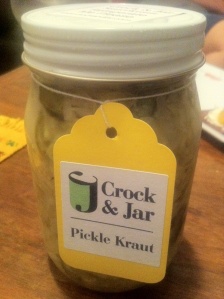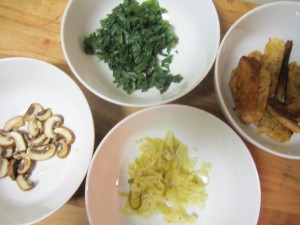In my family, we always say that failing to take a full course of antibiotics once you’ve taken the first pill has the potential impact of destroying all of society. There’s truth in this; taking a partial course of penicillin encourages infectious bacteria to develop resistant strains that will eventually be untreatable, and then we all might get scarlet fever and die.
But there’s an even bigger truth: not taking that first pill, and instead letting our bodies fight infections and develop antibodies, and constantly eating foods that encourage them to do so, actually makes the world a better place. In addition to potentially creating resistant bacteria strains, antibiotics like penicillin wipe out all the good bacteria in our bodies with the bacterial equivalent of a cropdusting treatment. And these days, antibiotics are showing up not only in our pharmacies, but sometimes in our milk and meat. So when we buy a corporate-big-farm-produced ice cream cone, we might actually be KILLING EVERYONE IN THE WORLD SLOWLY.
Oh dear.
Of course, the antidote to this glut of antibiotics is the magical, wonderful PRO-biotic. Probiotics are living microorganisms that make our bodies (aka the “host organism”) better, strengthening our immune system and our digestive system, and keeping all our other systems clean of toxins and functioning well.
Lactic acid bacteria (LAB) and bifidobacteria are the most common types of probiotics, and are in fermented foods with live cultures, like yogurt or (or kefir), miso, and the original probiotic superfood: saurkraut.
Saurkraut (and Kimchi, which has the same deal going for it) is what happens to cabbage (or daikon) when it gets old. Fresh cabbage is already pre-populated with the bacteria required to lactoferment itself. And, as all things, it really does get better with age- cabbage in its raw form contains substances called ‘goitrogens’ that can block the production of thyroid hormone, but goitrogens are reduced or eliminated through the fermentation process.
My friend Michaela of the awesome local Crock & Jar is a master-fermenter, and she gives great workshops on how to make your own krauts and fill the world with probiotics. (She’s giving one tomorrow on Governor’s Island at Cook Out NYC , which is also benefitting Just Foods Farm School). I got my hands on a few jars of her spicy kraut and pickle kraut, and when I’m not just standing in the kitchen eating them by the forkful, I use them to make probiotic-y awesome meals like these:
Pickle Kraut Tempeh Reuben*
Ingredients:
- 5-6 slices of Tempeh
- a few slices of your favorite whole-grain bread (all I had was sourdough, which is also good, but I think the seedier the better)
- a handful of Crock & Jar Pickle Kraut or your favorite (or your own homemade!) Kraut
- 1 teaspoon organic ketchup
- 1 teaspoon ground horseradish
- 1 tablespoon mayonaise or nayonaise or whatever you use
- a dash of paprika
- 1/4 teaspoon whole seed mustard or some toasted crushed mustard seeds
- a little soy sauce
- a handful of fresh spinach or collards or other greens- bitter is fine!- steamed, strained, and seasoned (I used kale because I had it in the garden)
- a few sliced and sauteed mushrooms- creminis or shitakes are the best
- some cheese if you want it (mine was pepper jack, but you can use anything! really!
- a little butter or oil
Directions:
- Mix the ketchup, mayo, paprika, mustard and horseradish together. Feel free to mess with the ratios to get it to the perfect zing and zang for your taste.
- Splash a little soy sauce in a pan with some oil and fry up your tempeh until it’s a bit browned.
- Remove your tempeh and assemble it with all the other ingredients between two slices of bread. Make sure your cheese is against one slice and your sauce against the other to keep the whole thing messy and delicious. Throw the greens, shrooms, tempeh, and kraut in the middle.
- Heat a little oil or butter in your pan on medium and toss the sandwich on it, pressing it down with the spatula to brown the bread and melt the cheese. Flip it over to do the same to the other side.
- Eat it with some of the delicious local berries from the farmers’ market. Feel healthier immediately.
*Bonus! Tempeh is ALSO a probiotic food, so this recipe gets pro-pro points.

 Spicy Kraut Lettuce Wraps
Spicy Kraut Lettuce Wraps
Ingredients:
- A cup or so of day-old rice (see Tony’s Plastic Bag Rice Recipe)
- A cup or so of Spicy Kraut or Kimchi, roughly chopped
- Fresh, carefully washed, lettuce leaves – I like green leaf or butter lettuce, but anything will do
- 1 egg
- A little soy sauce OR a smear of miso paste mixed with water (full of probiotics!)
- A few shitake mushrooms, sliced
- Fresh chopped scallions to taste
- A little bit of olive or sesame oil
Directions:
- Heat a little oil in the pan and throw in the mushrooms, scallions, and miso/soy. Saute for a minute or so.
- Throw the rice in the pan with everything else and mix it around.
- Beat the egg with 2 tablespoons of water. Drizzle it over the rice, stirring it in as you do.
- Remove all this from the heat and put it in a glass or ceramic bowl. Add in the kraut and toss.
- Place 2-3 tablespoons of the rice mixture into a leaf of lettuce and roll it up like a burrito. Eat immediately!
 Oooooooooh Pie Eaters I have missed you!!!!!! I thought when summer was over that pie days were over too. Not true! I have made two new pies since summer. (And I have made, like, 12 salty honey pies. No exaggeration.) I wanted to make some season appropriate pies when fall started and the first one I want to tell you about is Cranberry-Sage Pie.
Oooooooooh Pie Eaters I have missed you!!!!!! I thought when summer was over that pie days were over too. Not true! I have made two new pies since summer. (And I have made, like, 12 salty honey pies. No exaggeration.) I wanted to make some season appropriate pies when fall started and the first one I want to tell you about is Cranberry-Sage Pie.













